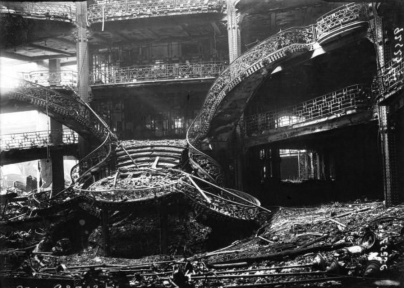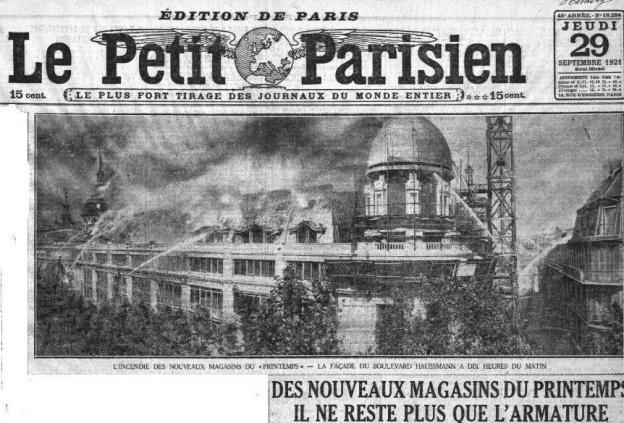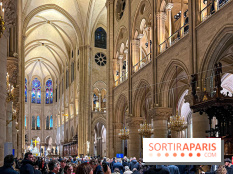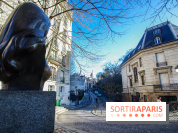On Wednesday, September 28, 1921, a fire broke out in the second building of the Printemps department store on Boulevard Haussmann in the 9th arrondissement of Paris. The flames quickly consumed part of the interior, and the roof collapsed despite the intervention of numerous firefighters. Fortunately, the sumptuous facade survived the disaster.
Built by Jules Jaluzot, a former employee of Bon Marché Rive Gauche, the first Printemps store opened its doors in 1865 on the corner of rue du Havre, rue de Provence, rue de Caumartin and boulevard Haussmann. But the history of this first building was short-lived, as it was completely destroyed by fire in 1881. It was then decided to have the department store rebuilt byarchitect Paul Sédille with a luxury and sumptuousness never before seen in the capital.
On the outside, the rue du Havre facade was preserved, while imposing statues representing the four seasons, the work of sculptor Henri Chapu, were installed above each arcade at the entrance, and four imposing gilded rotundas were built at each corner of the building, on which the name of the department store was engraved, embellished with floral motifs.
Inside, underneath the stone shell, architect Paul Sédille, inspired by Gustave Eiffel's constructions, imagined an immense iron frame and a majestic glass roof, which later disappeared when the store was raised, to bathe the open galleries in natural light.
The height of modernity, given the trauma caused by the first fire, Le Printemps, described by Zola as the "cathedral of commerce", was the first Parisian store to be entirely lit by electricity, as early as 1883, with an electric factory installed below to supply the necessary power.
Between 1907 and 1910, in response to the success of Le Printemps, which was rapidly becoming a landmark for Parisians on the go, a second building was constructed next door to the first byarchitect René Binet. Adopting the architectural style and motifs of the first Printemps, the architect added even more Art Nouveau pomp and pageantry, adorning the rotundas with statues by sculptor Anatole Guillot and creating a double dome to light the octagonal central hall.
In 1912, the second store was enlarged on Rue Charras byarchitect Georges Wybo, who created a second entrance hall. But on the morning of September 28, 1921 , the continuing development of these department stores took a turn for the worse .
It was still early on the morning of September 28, 1921, when a rumor spread like wildfire across the capital: the Nouveaux Magasins du Printemps was engulfed in flames. The fire quickly engulfed the interior of the department store, despite the intervention of numerous firefighters dispatched from all Parisian fire stations. The firefighters worked tirelessly to contain the blaze, which had broken out in theannex under construction.
But nothing helped: the damage was considerable, and the building constructed by Binet and Wybo was partially ravaged by flames. The roof collapsed in the central part of the building, taking with it the staircases and part of the floors between the upper floors and on the first floor. Wax mannequins melted on their display stands.
Fortunately, not all of the 3,000-strong workforce had yet arrived on site when the fire broke out; only a few store assistants and deliverymen were present, along with some 30 night watchmen and civilian firemen on duty. Miraculously, the facade of the building withstood the terrible event, while onlookers gathered on the boulevard watched in amazement and anguish, prevented from getting too close to the blaze by the Guardia Civil .
The next day, thePrintemps fire hit the headlines. "The fire reached its height of violence around eleven o'clock in the morning. It wasn't until around 4 p.m. that the desolate sight was revealed. All that remained were the four walls and, in the middle, the staircase, whose bottom had collapsed but whose landings had held and remained suspended in the middle of the void" wrote Le Petit Parisien.
But at the time, there was no short-time working and no investigation, and on September 29, 1921, Printemps reopened its doors to the public, with management stating in a press release: "Merchandise reserves, workshops and departments are completely unharmed, allowing shelves to be rebuilt, and sales to resume on Friday September 30. Shipping departments in Paris and the provinces will continue to operate and handle shipments from the evening of the 29th.
"In less than 48 hours, the shelves were reorganized and regrouped: two floors of the old stores, previously occupied by services, will be assigned to sales, as well as part of the rue de Provence annex. Delivery and shipping services have not been interrupted. Merchandise stocks are intact, enabling us to meet all orders," emphasized the daily newspapers of the time.
Between 1921 and 1924, Georges Wybo rebuilt the Printemps on the same plan. A large rotunda with geminated columns was built at the corner of boulevard Haussmann and rue Charras, while inside, René Binet's dome and its polychrome, flower-filled glass roof, the work of master glassworker Brière, miraculously withstood the flames and is still admired by Parisians and tourists alike.
Find out more:
Location
Le Printemps Haussmann
64, bd Haussmann
75009 Paris 9
More information
Iconography: Printemps fire on September 28, 1921, Agence Meurisse, Gallica



























